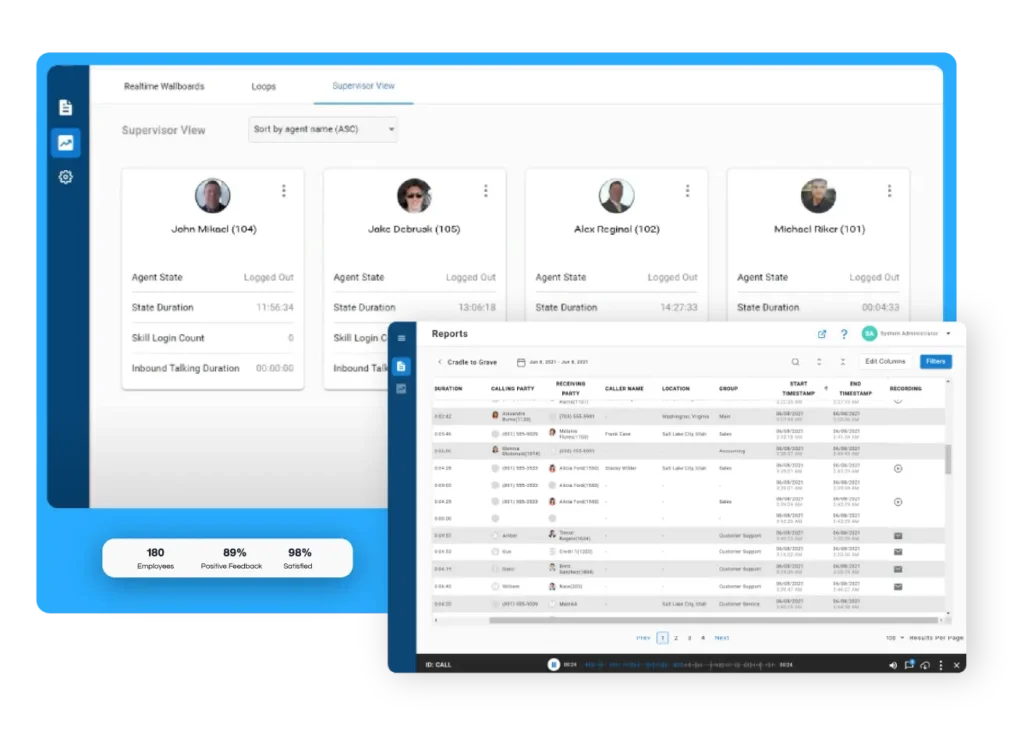For many small and mid-sized businesses, the contact center is the first touchpoint customers have with your brand, making it a critical part of the overall experience. Without effective reporting, it becomes difficult to see what is working, where challenges are occurring, or how performance impacts customer satisfaction.
Contact center reporting turns everyday interactions, such as call volume, wait times, resolutions, and agent productivity, into actionable insights that help businesses improve efficiency and deliver stronger customer outcomes. In this blog, we’ll explain what contact center reporting is, why it matters for SMBs, and the key metrics you should focus on.
What is Contact Center Reporting?
Contact center reporting is the process of collecting, analyzing, and presenting data from day-to-day operations in a way that highlights performance and efficiency. It encompasses everything from tracking call volume and average handle time to monitoring agent productivity and customer satisfaction. Organizing this information into reports and dashboards enables businesses to visualize key metrics, spot patterns, and identify areas for improvement.
Why Basic Contact Center Reporting is Essential for Small Businesses
Every customer interaction matters for a small business. Limited resources often mean teams must do more with less, so it’s crucial to understand exactly how the contact center is performing. Even the most basic reports provide valuable insights that can help:
Identify Operational Gaps and Pain Points
Contact center reports can quickly reveal where problems exist within your processes. Metrics such as long wait times, frequent call transfers, or unresolved issues can indicate staffing shortages, training gaps, or process bottlenecks. Spotting these problems early allows businesses to make targeted improvements that keep operations running smoothly.
Measure Efficiency and Productivity
Tracking core metrics gives leaders a clear picture of how efficiently their teams are working. From average handle time to call resolution rates, reporting makes it easier to evaluate agent productivity, assess how resources are allocated, and ensure the overall flow of operations is as effective as possible.
Establish Performance Baselines
Reporting creates a starting point for measuring success. Capturing initial performance data enables small businesses to easily set benchmarks, establish realistic goals, and track progress over time. This foundation allows businesses to accurately measure the impact of new strategies and make informed adjustments.
Enhance Customer Experience
Customer satisfaction is often the most important outcome of contact center performance. Reports provide insights into response times, resolution rates, and customer feedback. These metrics reveal opportunities to reduce friction, improve service quality, and build stronger customer relationships.
Key Contact Center Metrics for Small Business Growth
Tracking specific metrics helps leaders connect daily operations to long-term business goals, ensuring that customer satisfaction and efficiency go hand in hand. Below are the most important KPIs (Key Performance Indicators) for SMBs and the insights they provide.
Customer Experience Metrics
These metrics reflect how customers perceive their interactions with your business. They are directly tied to loyalty, retention, and overall brand reputation.
- Customer Satisfaction (CSAT): Measures how satisfied customers are after an interaction. High CSAT scores indicate strong service quality.
- Net Promoter Score (NPS): Gauges customer loyalty by asking how likely they are to recommend your business. A higher score suggests stronger brand advocacy.
- Customer Effort Score (CES): Tracks how easy it is for customers to resolve issues. Lower effort means a smoother experience and better long-term loyalty.
- First Contact Resolution (FCR): Measures the percentage of issues resolved on the first interaction. High FCR reduces repeat calls and improves customer confidence.
Operational Efficiency Metrics
These metrics focus on how effectively the contact center functions. Optimizing them reduces costs and allows small businesses to scale service delivery more efficiently.
- Average Handle Time (AHT): Captures the average time spent on each interaction. Balancing AHT ensures agents are efficient without sacrificing quality.
- Service Level: Tracks the percentage of calls answered within a set timeframe. Meeting service levels keeps wait times manageable and customers satisfied.
- Abandonment Rate: Shows how often customers hang up before reaching an agent. A high rate points to staffing or process issues.
- Occupancy Rate: Measures how much time agents spend handling calls versus waiting for them. A balanced rate helps prevent burnout while ensuring efficiency.
- Cost Per Contact: Calculates the expense of each interaction. Lowering this cost without reducing quality supports profitable growth.
Agent Performance Metrics
Agent effectiveness influences customer experience and operational success. These metrics help small businesses evaluate performance and support agent development.
- Adherence to Schedule: Tracks whether agents follow their assigned work schedules. Consistency ensures resources are available when customers need them.
- Quality Score: Evaluates how well agents follow scripts, policies, and service standards. High scores reflect strong training and consistent customer care.
- After-Call Work (ACW) Time: Measures the time agents spend wrapping up tasks after a call. Lower ACW keeps workflows moving smoothly.
- Agent Utilization: Shows how much of an agent’s time is spent on customer-facing work. Proper utilization balances workload while maximizing productivity.
Reporting vs. Analytics: Understanding the Difference
While reporting and analytics are often used interchangeably, they serve different purposes in a contact center. Reporting provides a snapshot of what has happened, such as the number of calls handled in a day or the average wait time customers experienced. It focuses on delivering clear, accurate numbers that highlight performance and activity.
Analytics, on the other hand, digs deeper to explain why those numbers look the way they do and what steps should be taken next. For example, analytics can reveal that a spike in call volume was triggered by a new product launch and that additional staffing or training is needed to maintain service levels. Both reporting and analytics are essential, but reporting builds the foundation for visibility and accountability, while analytics transforms data into actionable insights that drive strategic growth.
|
Aspect |
Reporting |
Analytics |
|
Primary Purpose |
Tells you what happened |
Explains why it happened and what to do next |
|
Focus |
Historical data and performance tracking |
Trends, patterns, and predictive insights |
|
Example Output |
“We received 1,200 calls this week.” |
“Call volume increased 20% due to a product launch, so staffing should be adjusted.” |
|
Value for SMBs |
Provides visibility into day-to-day operations |
Guides strategic decision-making and long-term growth |
|
Level of Insight |
Descriptive |
Diagnostic, predictive, and prescriptive |
Contact Center Reporting Best Practices for Small Businesses
Small business contact center reporting should balance simplicity with scalability. The right approach ensures leaders have the insights they need without overwhelming teams or stretching resources too thin. The best practices outlined below can help your business develop reporting strategies that evolve as the business grows while delivering meaningful returns.
Define Clear Reporting Goals and KPIs
The foundation of effective reporting starts with clarity. Align reporting objectives with overall business goals so every report has a clear purpose. If the goal is to reduce costs, metrics like cost per contact or agent utilization should be prioritized. If the focus is on improving customer satisfaction, analyze customer feedback scores and first contact resolution rates. Defining what success looks like ensures that reporting provides actionable insights rather than just numbers.
Embrace Real-time Monitoring and Alerts
Dashboards and automated alerts allow supervisors to see performance as it unfolds and respond quickly to unexpected changes. For example, a spike in wait times can trigger an alert, prompting immediate staffing adjustments before customer satisfaction is impacted. This proactive approach helps SMBs maintain service levels and agility even during peak periods.
Empower Users with Self-Service Reporting
Reporting is most effective when the right people have easy access to the right data. Providing managers and agents with customizable dashboards enables SMBs to foster accountability and encourage data-driven decision-making across teams. Self-service reporting reduces bottlenecks, allows for faster problem-solving, and gives employees the tools to monitor their own performance in real time.
Common Contact Center Report Examples
Reporting is most valuable when it translates raw data into insights that directly support business growth. Contact center solutions like Xima make it possible for small businesses to scale reporting capabilities while uncovering deeper performance trends. Below are a few examples of contact center reporting and contact center solutions in action.
Agent Reporting Summaries
Agent performance summaries, like Xima’s scorecard and evaluation features, track how agents perform against key goals. Some solutions offer benchmarks, such as badges or leaderboards. Making performance measurable and engaging helps businesses motivate teams while maintaining accountability.
Call Details
Granular call data reports and live agent call recordings provide a detailed view of each customer interaction. This includes call direction, duration, start and end times, dialed numbers, and whether the call was internal or external. With this level of visibility, managers can quickly identify patterns and address potential issues.
Cradle-to-Grave Analysis
Cradle-to-grave reporting connects every interaction across channels. This advanced capability allows SMBs to see how a conversation started, where it moved, and how it was resolved, creating valuable context for service improvements.
Driving Success for Small Businesses with Contact Center Reporting
For SMBs, contact center reporting is a growth strategy that turns everyday interactions into actionable insights. With clear visibility into operations, businesses can identify inefficiencies, improve agent productivity, and strengthen customer relationships. As reporting evolves into analytics, leaders gain the deeper insights needed to make proactive decisions that drive sustainable success.
The right tools allow small businesses to scale reporting without adding unnecessary complexity. Xima’s solutions help track the metrics that matter, reveal meaningful trends, and give teams the visibility needed to deliver better service.
Ready to see how Xima can transform your reporting strategy? Book a demo today!



